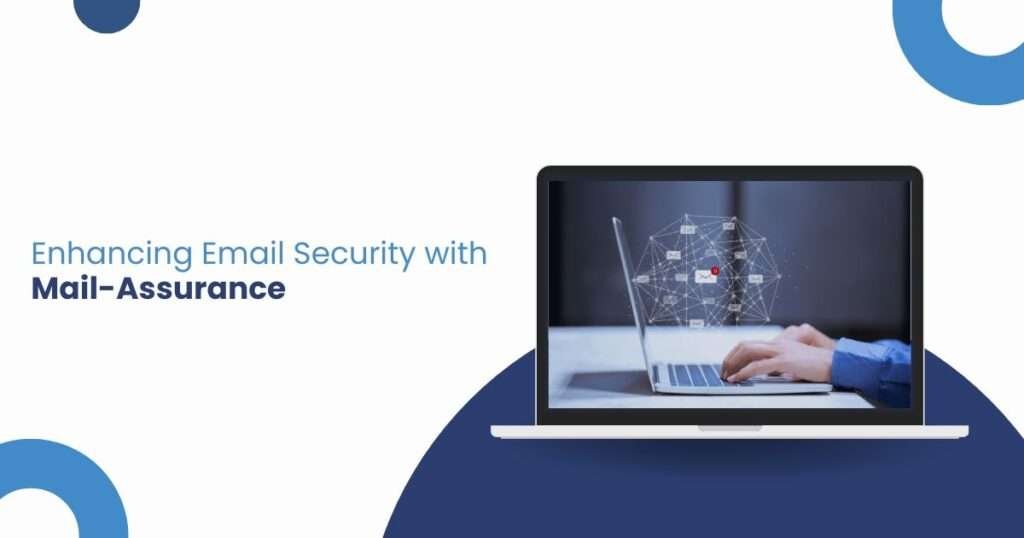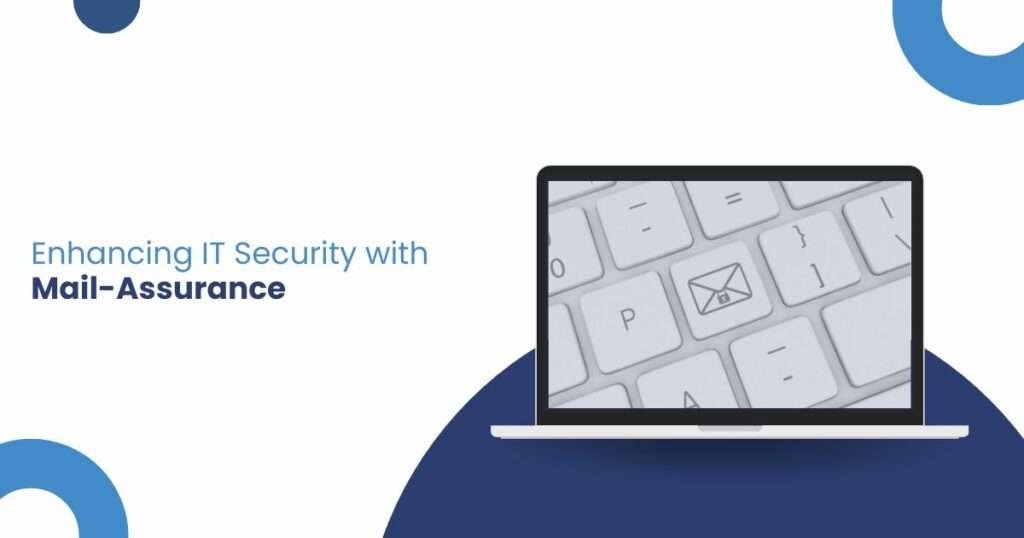Enhancing Email Security with Mail-Assurance:

In today’s digital age, email has become an indispensable tool for communication in both personal and professional spheres. However, with the increasing reliance on email comes the heightened risk of cyber threats and attacks. This is where email security steps in – a robust solution designed to enhance Mail Assurance and safeguard sensitive information from malicious actors. Mail-Assurance: Enhancing Email Security Mail-Assurance is a cutting-edge email security service that offers comprehensive protection against a wide range of email security. From phishing attacks to malware infections, Mail-Assurance employs advanced security measures to keep your email communications secure and confidential. Understanding the Importance of Email Security in IT Management Email security is paramount in IT management, as email remains one of the primary vectors for cyber-attacks. Without adequate protection, organizations are vulnerable to data breaches, financial losses, and damage to their reputation. By implementing Mail-Assurance, IT managers can mitigate these risks and ensure the integrity and confidentiality of their email communications. Implementing Mail-Assurance: Key Components and Features Mail-Assurance encompasses a suite of key components and features designed to provide comprehensive email security. These include: Advanced threat detection: Mail-Assurance employs sophisticated algorithms to identify and neutralize threats in real-time, including phishing attempts, malware, and spam. Secure email gateways: By routing all incoming and outgoing email through secure gateways, Mail-Assurance ensures that only legitimate and safe messages reach their intended recipients. Email encryption: With built-in encryption capabilities, Mail-Assurance encrypts sensitive information to prevent unauthorized access and ensure confidentiality. Data loss prevention (DLP): Mail-Assurance helps organizations prevent data breaches by monitoring and controlling the transmission of sensitive data via email. Threat Landscape: Identifying Risks to Email Communication The threat landscape for email communication is constantly evolving, with cybercriminals employing increasingly sophisticated tactics to bypass traditional security measures. Common threats include: Phishing attacks: Cybercriminals impersonate legitimate entities to trick users into divulging sensitive information such as login credentials or financial data. Malware infections: Malicious software such as ransomware or trojans can infiltrate systems via email attachments or links, causing significant damage to data and systems. Spam and junk mail: Unsolicited emails not only clutter inboxes but can also serve as vehicles for malware distribution or phishing attempts. By understanding the risks posed by these threats, organizations can better appreciate the importance of implementing robust email security measures such as Mail-Assurance. Mail-Assurance Solutions: Choosing the Right IT Managed Service Provider When selecting an IT managed service provider for Mail-Assurance, it’s essential to consider factors such as: Reputation and experience: Choose a provider with a proven track record of delivering reliable and effective email security solutions. Customization options: Look for a provider that offers flexible solutions tailored to your organization’s specific needs and requirements. Scalability: Ensure that the provider can accommodate your organization’s growth and evolving security needs over time. Support and maintenance: Opt for a provider that offers round-the-clock support and regular updates to ensure optimal performance and protection. By partnering with the right IT managed service provider, organizations can maximize the benefits of Mail-Assurance and enhance their email security posture. Secure Email Gateways: Safeguarding Against Malicious Attacks Secure email gateways play a crucial role in protecting organizations against malicious attacks by filtering incoming and outgoing email traffic. By analyzing email content and attachments in real-time, secure email gateways can identify and block potential threats before they reach users’ inboxes. With Mail-Assurance, organizations can leverage secure email gateways to minimize the risk of phishing attacks, malware infections, and other email-based threats. Advanced Threat Protection: Detecting and Neutralizing Email Threats Mail-Assurance utilizes advanced threat protection mechanisms to detect and neutralize email threats in real-time. By leveraging machine learning algorithms and behavioral analytics, Mail-Assurance can identify suspicious patterns and anomalies indicative of malicious activity. This proactive approach allows organizations to stay one step ahead of cybercriminals and protect their email infrastructure from emerging threats. Email Encryption: Protecting Sensitive Information in Transit Email encryption is a critical component of email security, particularly for organizations that handle sensitive or confidential information. With Mail-Assurance, organizations can encrypt email messages and attachments to prevent unauthorized access and ensure data confidentiality. By encrypting sensitive information in transit, organizations can mitigate the risk of data breaches and safeguard their reputation. Data Loss Prevention (DLP): Mitigating Risks of Data Breaches Data loss prevention (DLP) is essential for organizations seeking to protect sensitive data from unauthorized access or exfiltration. With Mail-Assurance, organizations can implement DLP policies to monitor and control the transmission of sensitive data via email. By identifying and blocking unauthorized attempts to send sensitive information, Mail-Confirmation helps organizations mitigate the risk of data breaches and regulatory compliance violations. Regulatory Compliance: Ensuring Email Security Standards Compliance with regulatory requirements is a top priority for organizations across industries, particularly those handling sensitive or regulated data. With Mail-Confirmation, organizations can ensure compliance with email security standards such as GDPR, HIPAA, and PCI DSS. By implementing robust security measures and controls, organizations can demonstrate their commitment to protecting sensitive information and avoiding costly penalties for non-compliance. Incident Response and Recovery: Strategies for Handling Email Security Breaches Despite best efforts to prevent email security breaches, organizations must be prepared to respond swiftly and effectively in the event of an incident. With Mail-Assurance, organizations can implement incident response and recovery strategies to minimize the impact of security breaches and restore normal operations as quickly as possible. By establishing clear protocols and procedures for incident detection, containment, and remediation, organizations can mitigate the damage caused by email security breaches and maintain customer trust and confidence. User Training and Awareness: Educating Employees on Email Security Best Practices User training and awareness are critical components of effective email security strategies. With Mail-Assurance, organizations can educate employees on email security best practices and empower them to recognize and report potential threats. By providing regular training sessions and awareness campaigns, organizations can foster a culture of security awareness and vigilance among employees, reducing the risk of successful phishing attacks and other email-based threats. Integration with IT Infrastructure: Seamless Implementation of Mail-Assurance Integration with existing IT
Enhancing IT Security with Mail-Assurance:

In the realm of IT management services, ensuring robust email security is paramount. With the ever-evolving landscape of email threat protection, organizations face unprecedented challenges in safeguarding their email communications. This is where Mail-Assurance emerges as a game-changer. In this comprehensive guide, we delve into the significance of Mail-Assurance and its multifaceted role in fortifying email security within IT managed services. Introduction to Mail-Assurance: Understanding the Importance in IT Management Services Mail-Assurance stands at the forefront of email security solutions, providing a holistic approach to safeguarding sensitive information exchanged via email channels. As organizations increasingly rely on email communication for business operations, the need for robust email security has never been more pressing. Mail-Assurance addresses this need by offering a suite of advanced features designed to mitigate risks associated with email-based threats. Key Features and Benefits of Mail-Assurance in IT Managed Services Mail-Assurance encompasses a plethora of features tailored to meet the diverse needs of IT managed services. From real-time threat detection to comprehensive email encryption, its key features include: – Advanced threat detection algorithms – Email content filtering and spam protection – Seamless integration with existing email platforms – User-friendly interface for easy deployment and management The benefits of Mail-Assurance extend beyond mere security enhancements. By mitigating the risks of email-based threats, organizations can experience: – Improved operational efficiency – Enhanced regulatory compliance – Increased customer trust and confidence Securing Email Communication: How Mail-Assurance Enhances IT Security Email communication forms the backbone of modern business operations. However, it also represents a prime target for cybercriminals seeking to exploit vulnerabilities. Mail-Assurance employs cutting-edge encryption techniques to secure email communication end-to-end. By encrypting both the content and attachments of outgoing emails, it ensures that sensitive information remains inaccessible to unauthorized parties. Email Filtering and Spam Protection: Leveraging Mail-Assurance for Enhanced Efficiency The proliferation of spam emails poses a significant threat to organizational productivity and security. Mail-Assurance tackles this challenge head-on with its robust email filtering and spam protection capabilities. By automatically identifying and quarantining suspicious emails, it minimizes the risk of users falling victim to phishing attacks or malware infections. Data Loss Prevention Strategies with Mail-Assurance in IT Managed Services Data loss can have severe repercussions for organizations, ranging from financial losses to reputational damage. Mail-Assurance offers comprehensive data loss prevention (DLP) strategies to mitigate these risks. By monitoring outbound email traffic and enforcing predefined policies, it prevents the unauthorized transmission of sensitive data, such as intellectual property or personally identifiable information. Compliance and Regulatory Requirements: Addressing Them with Mail-Assurance Solutions In today’s regulatory landscape, compliance with data protection and privacy regulations is non-negotiable. Mail-Assurance assists organizations in meeting their compliance obligations by providing robust security measures aligned with industry standards and regulations. Whether it’s GDPR, HIPAA, or PCI-DSS, Mail-Assurance offers tailored solutions to ensure adherence to regulatory requirements. Disaster Recovery and Continuity Planning: The Role of Mail-Assurance in IT Management Disruptions to email services can significantly impact business continuity and productivity. Mail-Assurance plays a vital role in disaster recovery and continuity planning by providing seamless failover capabilities and redundant infrastructure. In the event of an email server outage or data breach, organizations can rely on Mail-Assurance to maintain uninterrupted email communication and data access. Advanced Threat Protection: Safeguarding Against Email-Based Cyber Attacks Cyber threats are becoming increasingly sophisticated, making traditional security measures inadequate. Mail-Assurance leverages advanced threat protection mechanisms, such as machine learning algorithms and behavioral analysis, to detect and mitigate emerging threats in real time. By proactively identifying and neutralizing malicious email content, it fortifies the organization’s defenses against evolving cyber threats. Scalability and Customization: Tailoring Mail-Assurance to Fit IT Management Needs One size does not fit all when it comes to email security solutions. Mail-Assurance offers scalability and customization options to accommodate the unique requirements of each organization. Whether it’s a small business or a large enterprise, Mail-Assurance can be tailored to scale according to the organization’s size, industry, and specific security needs. Implementing Mail-Assurance: Best Practices and Considerations for IT Service Providers Successful implementation of email security requires careful planning and execution. IT service providers play a crucial role in guiding organizations through the deployment process and ensuring seamless integration with existing IT infrastructure. Key best practices and considerations include: – Conducting a thorough assessment of the organization’s email security needs – Customizing Mail-Assurance settings and policies to align with business objectives – Providing comprehensive training to end users on email security best practices – Regularly monitoring and updating Mail-Assurance configurations to adapt to evolving threats Final Thoughts: Mail-Assurance represents a comprehensive solution for enhancing email security within IT managed services. By leveraging its advanced features and capabilities, organizations can fortify their defenses against email-based threats, safeguard sensitive information, and ensure regulatory compliance. As cyber threats continue to evolve, Mail-Assurance remains a steadfast ally in the ongoing battle to secure email communication in the digital age.
